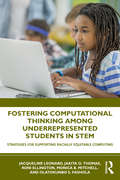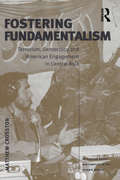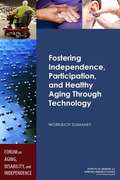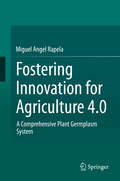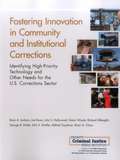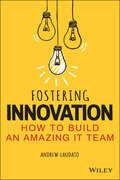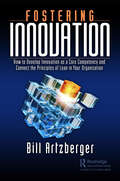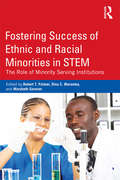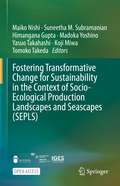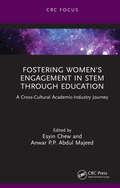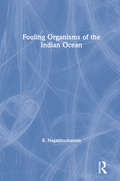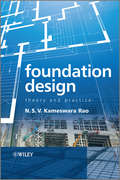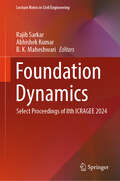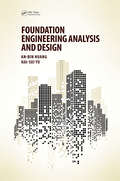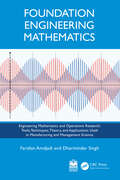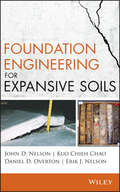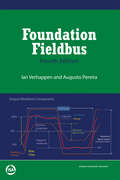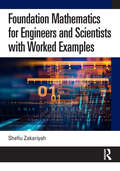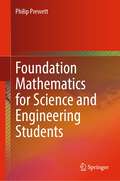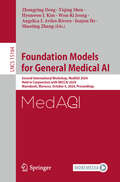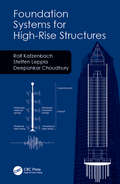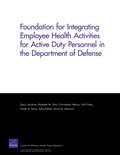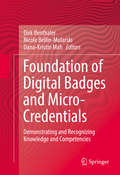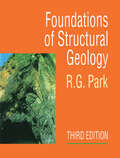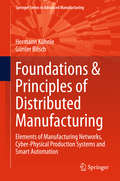- Table View
- List View
Fostering Computational Thinking Among Underrepresented Students in STEM: Strategies for Supporting Racially Equitable Computing
by Olatokunbo S. Fashola Jacqueline Leonard Jakita O. Thomas Roni Ellington Monica B. MitchellThis book broadly educates preservice teachers and scholars about current research on computational thinking (CT). More specifically, attention is given to computational algorithmic thinking (CAT), particularly among underrepresented K–12 student groups in STEM education. Computational algorithmic thinking (CAT)—a precursor to CT—is explored in this text as the ability to design, implement, and evaluate the application of algorithms to solve a variety of problems. Drawing on observations from research studies that focused on innovative STEM programs, including underrepresented students in rural, suburban, and urban contexts, the authors reflect on project-based learning experiences, pedagogy, and evaluation that are conducive to developing advanced computational thinking, specifically among diverse student populations. This practical text includes vignettes and visual examples to illustrate how coding, computer modeling, robotics, and drones may be used to promote CT and CAT among students in diverse classrooms.
Fostering Fundamentalism: Terrorism, Democracy and American Engagement in Central Asia (US Foreign Policy and Conflict in the Islamic World)
by Matthew CrosstonIs the United States, in its fight against terror and pursuit of Osama Bin Laden, recklessly creating conditions in Central Asia to produce the next Bin Laden? Matthew Crosston studies this controversial argument in his political analysis of US foreign policy on Central Asia. He looks specifically at the 'no-man's land nexus' connecting Tajikistan, Uzbekistan and Kyrgyzstan and the heart of Central Asian Islamic radicalism - the Fergana Valley. This book breaks new ground by examining in unflinching detail the unwitting role US foreign policy plays in fomenting that 'hot zone' and extremism, producing a new generation of Islamic radicals. University courses that deal with US foreign policy, international security, terrorism and/or Eurasian politics will want to make this book required reading.
Fostering Independence, Participation, and Healthy Aging Through Technology
by Institute of Medicine National Research Council Steve Olson Division of Behavioral and Social Sciences and Education Board on Health Sciences Policy Tracy A. Lustig Forum on Aging, Disability, and IndependenceThe Institute of Medicine (IOM) and the National Research Council (NRC) have had prominent roles in discussions of aging, disability, and technology for decades. In 1978, Aging and Medical Education (IOM, 1978) raised national awareness of the challenges to physicians posed by the aging of the U.S. population. Thirty years later, Retooling for an Aging America highlighted concerns for the entire health care workforce in view of the aging of the population, including the role of technology in caring for older populations. The 1988 report The Aging Population in the 21st Century examined social, economic, and demographic changes among older adults, as well as many health-related topics: health promotion and disease prevention; quality of life; health care system financing and use; and the quality of care-- especially long-term care. In 1991, the landmark report Disability in America laid out a national agenda to prevent disability and improve the lives of people with disabling conditions. The 1997 report Enabling America: Assessing the Role of Rehabilitation Science and Engineering examined the knowledge base of rehabilitation science and engineering and proposed ways to translate scientific findings into interventions that produce better health. And the 2007 report The Future of Disability in America examined progress made since the earlier reports and looked at continuing barriers that limit the independence, productivity, and participation in community life of people with disabilities. All these reports were produced by committees appointed in accordance with guidelines of the National Academies and met multiples times to compile and review evidence, reach consensus on conclusions and recommendations, draft a report of the committee, and then modify that draft report in response to comments from outside reviewers. The IOM and NRC have also held several workshops related to aging, disability, and technology and published summary reports, such as Technology for Adaptive Aging and Grand Challenges of Our Aging Society. The IOM and NRC also convene groups that take a different approach to issues of pressing national and international importance. Often known as forums or roundtables, these groups meet regularly to foster dialogue and confront issues of mutual interest and concern among a broad range of stakeholders. They can convene workshops, initiate cooperative projects among members, commission independently authored articles, and generate ideas for independent consensus studies. In 2012 the IOM and NRC joined together to establish the Forum on Aging, Disability, and Independence to provide a neutral venue for broad-ranging discussions among the many stakeholders involved with aging and disability. The goals of the forum are to highlight areas in which the coordination of the aging and disability networks is strong, examine the challenges involved in aligning the aging and disability networks, explore new approaches for resolving problem areas, elevate the visibility and broaden the perspectives of stakeholders, and set the stage for future policy actions. Forum sponsors and members include federal agencies, health professional associations, private sector businesses, academics, and consumers. Fostering Independence, Participation, and Healthy Aging Through Technology summarizes this workshop.
Fostering Innovation for Agriculture 4.0: A Comprehensive Plant Germplasm System
by Miguel Angel RapelaThe scientific and technical development of any kind of germplasm is regulated by a vast network of treaties, conventions, international agreements, and national and regional legislation. These regulations govern biotechnological innovations in plants and microorganisms, access to and use of plant genetic resources, and biosafety. This complex mix has made it difficult to arrive at global interpretations, due to overlaps, gaps, ambiguities, contradictions, and lack of consistency. The big picture is even more complex, as a series of scientific developments – gene editing in particular – have in some cases rendered these international regulatory frameworks obsolete.This book puts forward an innovative approach: a “Comprehensive Plant Germplasm System”. The System is a cooperative game theory-based proposal for a binding international convention which would supersede all other conventions, treaties, national and regional legislation covering native varieties and traditional developments, heterogeneous plant varieties, microorganisms, biotechnological inventions, plant genetic resources, and biosafety regulation. In short, it offers a comprehensive framework regarding intellectual property, biosafety, and business regulation and covers all types of germplasm.If applied, the system is expected to yield higher productivity rates in crops and improved food biodiversity, as well as a new paradigm based on the promotion of innovation for “Agriculture 4.0.”
Fostering Innovation in Community and Institutional Corrections: Identifying High-Priority Technology and Other Needs for the U.S. Corrections Sector
by Richard Silberglitt Brian A. Jackson Brian G. Chow John S. Hollywood Dulani Woods Joe Russo George B. Drake John S. Shaffer Mikhail ZaydmanGiven the challenges posed to the U. S. corrections sector, such as tightened budgets and increasingly complex populations under its charge, it is valuable to identify opportunities where changes in tools, practices, or approaches could improve performance. In this report, RAND researchers, with the help of a practitioner Corrections Advisory Panel, seek to map out an innovation agenda for the sector.
Fostering Innovation: How to Build an Amazing IT Team
by Andrew LaudatoProven and practical strategies for leading IT teams and departments In Fostering Innovation: How to Build an Amazing IT Team, accomplished technology strategist, executive, and leader Andrew Laudato delivers an eye-opening exploration of how to design, build, staff, and run a high-performing IT department. The book is filled with universally applicable strategies and techniques that can transform any IT team into an all-star cast perfectly aligned with your organization’s objectives. Incorporating proven and practical processes throughout the narrative, the book offers useful continuous improvement concepts the reader can apply to their team, company, and professional development. Readers will also find: Foolproof ways to put people before technology Detailed discussions of perennially important topics, like the importance of uptime, how to deploy redundancy, and creating the perfect organization chart Strategies for managing and motivating the wonderfully unique individuals we refer to as "technologists." The perfect resource for newly minted Chief Information Officers and Chief Technology Officers, Fostering Innovation will also earn a place in the libraries of non-technical professionals who work closely with IT, and business leaders seeking a better understanding of how to lead an IT team.
Fostering Innovation: How to Develop Innovation as a Core Competency and Connect the Principles of Lean in Your Organization
by Bill ArtzbergerWhile innovation can be defined in many ways, the author sees it as a process. It is not the sudden eureka moment in the middle of the night, nor is it a clear and linear path towards a final destination. Instead, it involves a strong sense of creativity and curiosity. An innovative mind has a natural inclination towards out-of-the-box thinking. It involves a willingness to try something new, without fear or judgment, to develop something no one else has ever articulated. While the mindset comes naturally, it requires fuel to keep it running. Innovators are voracious readers and researchers. They feed their mindset all of the fuel it needs to stay informed and relevant in their field. Many of the same things can be said for the Lean mindset. Lean management doesn’t happen overnight, and it is very rarely a clear and linear path to true Lean thinking. Some might consider Lean a subset of innovative thinking, while others see it in reverse. Regardless of the relationship’s directionality, one thing is certain: You cannot have one without the other. This book follows John Riley, the CEO of a medium-sized valve company just outside of Pittsburgh, Pennsylvania, who will stop at nothing to create an innovative work environment. Through the ups and downs of his journey, he learns a number of Lean and innovative skills, strategies, and mindsets to help him build the business he’s always envisioned for himself. Throughout the book, you see examples of both strong and poor innovative leadership skills demonstrated by each of the main characters. The key messages are ones that help leaders build and access a mindset insistent on continuous improvement. Leadership techniques and abilities that bolster creative thought and problem-solving are the most successful throughout this book. To be truly innovative, you can never stop driving the learning process. For this to happen, leaders need to recognize when there is a need for a change or improvement. This is the beauty of the marriage between Lean and innovation: They both require continuous learning and growth. The desire to improve is only one piece of this equation, however. The other is the willingness to act. Without both of these factors, true innovation will always be out of reach.
Fostering Success of Ethnic and Racial Minorities in STEM: The Role of Minority Serving Institutions
by Dina C. Maramba Marybeth Gasman Robert T. PalmerTo maintain competitiveness in the global economy, United States policymakers and national leaders are increasing their attention to producing workers skilled in science, technology, engineering, and mathematics (STEM). Given the growing minority population in the country, it is critical that higher education policies, pedagogies, climates, and initiatives are effective in promoting racial and ethnic minority students’ educational attainment in STEM. Minority Serving Institutions (MSIs) have shown efficacy in facilitating the success of racial and ethnic minority students in STEM and are collectively responsible for producing nearly one-third of the nation’s minority STEM graduates. In Fostering Success of Ethnic and Racial Minorities in STEM, well-known contributors share salient institutional characteristics, unique aspects of climate, pedagogy, and programmatic initiatives at MSIs that are instrumental in enhancing the success of racial and ethnic minority students in STEM education. This book provides recommendations on institutional practice, policy, and lessons that any institution can use on their campus to foster better retention and persistence among minority students. Higher Education leaders and administrators interested in encouraging achievement among racial and ethnic minority students in STEM education will find this book a welcomed and timely addition to the discourse on promoting minority student success.
Fostering Transformative Change for Sustainability in the Context of Socio-Ecological Production Landscapes and Seascapes (SEPLS)
by Himangana Gupta Maiko Nishi Suneetha M. Subramanian Madoka Yoshino Yasuo Takahashi Koji Miwa Tomoko TakedaThis open access book is a compilation of case studies that provide useful knowledge and lessons that derive from on-the-ground activities and contribute to policy recommendations, focusing on the relevance of social-ecological production landscapes and seascapes (SEPLS) to “transformative change.” The concept of “transformative change” has been gaining more attention to deal with today’s environmental and development problems, whereas both policy and scientific communities have been increasingly calling for transformative change toward sustainable society. The Intergovernmental Science-Policy Platform on Biodiversity and Ecosystem Services (IPBES) has planned to start the so-called “assessment on transformative change” if approved by the IPBES plenary to be held in 2021. At present, the idea of transformative change, including its scope, methodologies, approaches and strategies, are yet to be clarified. By bringing together all of the different concerns and interests in the land/seascape, SEPLS approaches could provide practical and experience-based insights for understanding and gauging transformative change and identifying determinants of such change. This book explores how SEPLS management relates to the idea of transformative change to further the discussion of sustainable transitions in advancing sustainability science. The introductory chapter is followed by case study chapters offering real-world examples of transformative change as well as a synthesis chapter clarifying the relevance of the case study findings to policy and academic discussions. It will be of interest to scholars, policymakers and professionals in the fields related to sustainable development.
Fostering Women's Engagement in STEM Through Education: A Cross-Cultural Academic-Industry Journey
by Esyin Chew Majeed, Anwar P.P. AbdulFostering Women's Engagement in STEM Through Education: A Cross-Cultural Academic-Industry Journey uniquely intertwines academic rigour with real-world impact, offering a comprehensive exploration of science, technology, engineering, and mathematics (STEM) experiences forged through the Partnership for Innovation in Employability (PIE) programme. The PIE programme, funded by the British Council, is aimed at nurturing innovation and facilitating interaction to enhance employability within educational robotics.This book brings together participating universities and industry partners from across the world to celebrate and share a variety of case studies showcasing the application of STEM education in various settings – from industrial to primary education. It not only illuminates successes, but critically evaluates challenges faced, and concludes with a look to the future for women in STEM education, research, and professional roles.Key features:· Offers a comprehensive, global perspective on the challenges and opportunities in promoting gender equality and diversity in STEM fields through education and outreach programmes, featuring case studies from Wales and Malaysia.· Provides actionable insights and recommendations for educators, policymakers, and stakeholders to develop and implement effective strategies for bridging the STEM gender gap and fostering inclusivity in education.· Explores innovative pedagogical approaches, such as game-based learning using traditional folk games, and the integration of cutting-edge technologies (e.g. collaborative robots) to engage learners from diverse backgrounds.This serves as a key resource for individuals engaged in professions connected to and researching STEM education, especially those dedicated to promoting and enhancing women's involvement in these fields.
Fouling Organisms of the Indian Ocean
by Rachakonda NagabhushanamMarine fouling organisms attach permanently to ship hulls and underwater parts of offshore structures. All maritime nations spend millions, even billions of dollars to get rid of them. Believing that a pooling of knowledge of all aspects of the basic biology of fouling organisms and a re-examination of control technology methods are steps needed for the solution of this problem, the aim of the book is to highlight recent advances in fouling control technology and, at the same time, provide basic information on the biology of fouling organisms found in the Indian Ocean. The book begins by presenting an overview of research done in India on the marine fouling organisms and wood-borers of the Indian Ocean. It them moves through chapters dealing with the seccession of fouling communities, chemical cues in larval settlement, epibiosis, methods of fouling prevention, functional morphology, and distribution of foulers in Indian waters.
Foundation Design: Theory and Practice
by N. S. RaoIn Foundation Design: Theory and Practice, Professor N. S. V. Kameswara Rao covers the key aspects of the subject, including principles of testing, interpretation, analysis, soil-structure interaction modeling, construction guidelines, and applications to rational design. Rao presents a wide array of numerical methods used in analyses so that readers can employ and adapt them on their own. Throughout the book the emphasis is on practical application, training readers in actual design procedures using the latest codes and standards in use throughout the world. Presents updated design procedures in light of revised codes and standards, covering: American Concrete Institute (ACI) codes Eurocode 7 Other British Standard-based codes including Indian codes Provides background materials for easy understanding of the topics, such as: Code provisions for reinforced concrete Pile design and construction Machine foundations and construction practices Tests for obtaining the design parameters Features subjects not covered in other foundation design texts: Soil-structure interaction approaches using analytical, numerical, and finite element methods Analysis and design of circular and annular foundations Analysis and design of piles and groups subjected to general loads and movements Contains worked out examples to illustrate the analysis and design Provides several problems for practice at the end of each chapter Lecture materials for instructors available on the book's companion website Foundation Design is designed for graduate students in civil engineering and geotechnical engineering. The book is also ideal for advanced undergraduate students, contractors, builders, developers, heavy machine manufacturers, and power plant engineers. Students in mechanical engineering will find the chapter on machine foundations helpful for structural engineering applications. Companion website for instructor resources: www.wiley.com/go/rao
Foundation Dynamics: Select Proceedings of 8th ICRAGEE 2024 (Lecture Notes in Civil Engineering #572)
by Abhishek Kumar Rajib Sarkar B. K. MaheshwariThis book will present the select proceedings of the 8th International Conference on Recent Advances in Geotechnical Earthquake Engineering and Soil Dynamics (8ICRAGEE) held at the Indian Institute of Technology (IIT), Guwahati between December 11 and 14, 2024. It contains the latest research papers covering the contributions and accomplishments in geotechnical earthquake engineering and soil dynamics in the last four years. The five volumes of the book cover a wide range of topics, including but not limited to seismic hazard analysis, wave propagation and site characterization, dynamic properties and liquefaction of soils, pile foundations, offshore foundations, seismic design of retaining structures and dams, seismic slope stability and landslides, dynamic soil-structure interaction, seismic design of structures. Further, recent developments on these topics are covered in different chapters. This book will be valuable not only for researchers and professionals but also for drawing an agenda for future courses of action from the perspective of geotechnical earthquake engineering, keeping the national need at the forefront.
Foundation Engineering Analysis and Design
by Hai-Sui Yu An-Bin HuangOne of the core roles of a practising geotechnical engineer is to analyse and design foundations. This textbook for advanced undergraduates and graduate students covers the analysis, design and construction of shallow and deep foundations and retaining structures as well as the stability analysis and mitigation of slopes. It progressively introduces critical state soil mechanics and plasticity theories such as plastic limit analysis and cavity expansion theories before leading into the theories of foundation, lateral earth pressure and slope stability analysis. On the engineering side, the book introduces construction and testing methods used in current practice. Throughout it emphasizes the connection between theory and practice. It prepares readers for the more sophisticated non-linear elastic-plastic analysis in foundation engineering which is commonly used in engineering practice, and serves too as a reference book for practising engineers. A companion website provides a series of Excel spreadsheet programs to cover all examples included in the book, and PowerPoint lecture slides and a solutions manual for lecturers. Using Excel, the relationships between the input parameters and the design and analysis results can be seen. Numerical values of complex equations can be calculated quickly. non-linearity and optimization can be brought in more easily to employ functioned numerical methods. And sophisticated methods can be seen in practice, such as p-y curve for laterally loaded piles and flexible retaining structures, and methods of slices for slope stability analysis.
Foundation Engineering Mathematics (Engineering Mathematics and Operations Research)
by Faridon Amdjadi Dharminder SinghMathematics plays a central role in modern culture, and a basic understanding of the nature of mathematics is required for scientific literacy. This new textbook will prepare readers to continue to develop analytical and numerical skills through the study of a variety of mathematical techniques. The statistical element of this textbook enhances the readers’ ability to organize and interpret data. Most of the topics covered in this textbook are widely used in various areas of engineering, including industrial engineering, to analyze complex systems, optimize processes and make informed decisions to improve efficiency, productivity and reliability in various industrial settings.From the complexities of double integration and ordinary differential equations to the complexities of linear systems of differential equations, Fourier series and Laplace transform, Foundation Engineering Mathematics unfolds with careful attention to detail, offering readers a structured approach to mastering these fundamental topics. Each chapter book is carefully presented to provide a balance between theoretical foundations and practical applications, ensuring that readers not only grasp the underlying principles but also appreciate their relevance in real-world engineering scenarios. Each chapter is accompanied by practical examples, illustrative diagrams and engineering applications to reinforce understanding and demonstrate the relevance of mathematical concepts in engineering practice.Whether you're a student embarking on your journey into the world of mathematics or a experienced engineer seeking to deepen your understanding of mathematical concepts, this book serves as an invaluable resource, guiding you through the complexities of mathematical theory and its engineering applications.A solutions manual and a set of PowerPoint slides are available for qualified textbook adoptions.
Foundation Engineering for Expansive Soils
by John D. Nelson Kuo Chieh Chao Erik J. Nelson Daniel D. OvertonYour guide to the design and construction of foundations onexpansive soils Foundation Engineering for Expansive Soils fills asignificant gap in the current literature by presenting coverage ofthe design and construction of foundations for expansive soils.Written by an expert author team with nearly 70 years of combinedindustry experience, this important new work is the only modernguide to the subject, describing proven methods for identifying andanalyzing expansive soils and developing foundation designsappropriate for specific locations.Expansive soils are found worldwide and are the leading cause ofdamage to structural roads. The primary problem that arises withregard to expansive soils is that deformations are significantlygreater than in non-expansive soils and the size and direction ofthe deformations are difficult to predict. Now, FoundationEngineering for Expansive Soils gives engineers and contractorscoverage of this subject from a design perspective, rather than atheoretical one. Plus, they'll have access to case studies coveringthe design and construction of foundations on expansive salts fromboth commercial and residential projects.Provides a succinct introduction to the basics of expansivesoils and their threatsIncludes information on both shallow and deep foundationdesignProfiles soil remediation techniques, backed-up with numerouscase studiesCovers the most commonly used laboratory tests and siteinvestigation techniques used for establishing the physicalproperties of expansive soilsIf you're a practicing civil engineer, geotechnical engineer orcontractor, geologist, structural engineer, or an upper-levelundergraduate or graduate student of one of these disciplines,Foundation Engineering for Expansive Soils is a must-haveaddition to your library of resources.
Foundation Fieldbus, Fourth Edition
by Ian VerhappenThe fourth edition of Foundation Fieldbus significantly expands the subject matter of the earlier editions of this popular book not only to help you stay current with this evolving technology but to also enhance your understanding of Fieldbus. This edition provides in-depth coverage on Fieldbus communications and configuration, including calculation of macrocycle for Control-In-Field and in the Host system and how the different forms of communication on the H1 network work with each other to make Control-In-Field possible, including the use of these different methods to optimize network bandwidth. Part of the field network evolutionary process includes a need to understand better how the changes in Electronic Device Description Language (EDDL), Field Device Tool (FDT), and Field Device Integration (FDI) will affect the way Fieldbus and other networks work together with asset management systems of the future, and your interaction with field devices. More comprehensive step-by-step procedures are discussed for each stage of a typical FF installation: Inspection and electric commissioning to ensure cable integrity, H1 Network commissioning, configuration, and communications tests in the segments and the spurs. Several new photographs and explanations help emphasize the proper installation procedures so you can quickly identify and prevent potential problems when installing Fieldbus systems. The contents of the entire book are then put to use with a full sample network design. The example is based on a typical simplified distillation tower and includes sample calculations/documentation-based. The fourth edition explains Foundation Fieldbus in a convenient, easy-to-understand way, regardless of your level of experience; a novice wanting to learn what FF is all about or an experienced user looking for a few more tips and a single handy reference.
Foundation Mathematics for Engineers and Scientists with Worked Examples
by Shefiu ZakariyahFoundation Mathematics for Engineers and Scientists with Worked Examples covers fundamental topics in mathematics required for science and engineering disciplines. It is primarily designed to provide a comprehensive, straightforward and step-by-step presentation of mathematical concepts to engineers, scientists and general readers. It moves from simple to challenging areas, with carefully tailored worked examples of different degrees of difficulty. Mathematical concepts are deliberately linked with appropriate engineering applications to reinforce their value and are aligned with topics taught in major overseas curriculums. This book is written primarily for students at levels 3 and 4 (typically in the early stages of a degree in engineering or a related discipline) or for those undertaking foundation degree, Higher National Certificate (HND), International Foundation Year (IFY), and International Year One (IYO) courses with math modules. It consists of seven parts: Basic concepts in Mathematics Coordinate Geometry Algebraic Expression and Equations Surds Indices and Logarithms Polynomials Trigonometry Each chapter is devoted to a topic and can be used as a stand-alone guide with no prior knowledge assumed. Additional exercises and resources for each chapter can be found online. To access this supplementary content, please go to www.dszak.com.
Foundation Mathematics for Science and Engineering Students
by Philip PrewettThis compact textbook provides a foundation in mathematics for STEM students entering university. The book helps students from different disciplines and backgrounds make the transition to university. Based on the author’s teaching for many years, the book can be used as a textbook and a resource for lecturers and professors. Its accessibility is such that it is can also be used by students in their final year in school before university and help them continue their mathematical studies at college. The book is designed so that students will return to the book repeatedly as their undergraduate careers progress. Although compact and concise, it loses no rigour. All the topics are carefully explained meaningfully, not just presented as a set of rules or rote-learned procedures.
Foundation Models for General Medical AI: Second International Workshop, MedAGI 2024, Held in Conjunction with MICCAI 2024, Marrakesh, Morocco, October 6, 2024, Proceedings (Lecture Notes in Computer Science #15184)
by Shaoting Zhang Won-Ki Jeong Yiqing Shen Zhongying Deng Hyunwoo J. Kim Angelica I. Aviles-Rivero Junjun HeThis book constitutes the refereed proceedings from the Second International Workshop on Foundation Models for General Medical AI, MedAGI 2024, held in conjunction with the 27th International conference on Medical Image Computing and Computer Assisted Intervention, MICCAI 2024, in Marrakesh, Morocco in October 2024. The 17 papers included in this book were carefully reviewed and selected from 26 submissions. These papers provide insights into the current landscape of medical AI and foundation models, that can pave the way for the evolution of task-specific medical AI systems into more generalized frameworks capable of tackling a diverse range of tasks, datasets, and domains.
Foundation Systems for High-Rise Structures
by Deepankar Choudhury Rolf Katzenbach Steffen LepplaThe book deals with the geotechnical analysis and design of foundation systems for high-rise buildings and other complex structures with a distinctive soil-structure interaction. The basics of the analysis of stability and serviceability, necessary soil investigations, important technical regulations and quality and safety assurance are explained and possibilities for optimised foundation systems are given. Additionally, special aspects of foundation systems such as geothermal activated foundation systems and the reuse of existing foundations are described and illustrated by examples from engineering practice.
Foundation for Integrating Employee Health Activities for Active Duty Personnel in the Department of Defense
by Christopher Nelson Elizabeth M. Sloss Gary Cecchine Gail Fisher Preethi R. SamaThe authors describe current Department of Defense safety and occupational health programs and health information systems, as well as employee health programs outside of DoD to provide a foundation for considering a more integrated Department of Defense employee health program.
Foundation of Digital Badges and Micro-Credentials
by Dirk Ifenthaler Nicole Bellin-Mularski Dana-Kristin MahThis edited volume provides insight into how digital badgesmay enhance formal, non-formal and informal education by focusing on technicaldesign issues including organizational requirements, learning and instructionaldesign, as well as deployment. It features current research exploring thetheoretical foundation and empirical evidence of the utilization of digitalbadges as well as case studies that describe current practices and experiencesin the use of digital badges for motivation, learning, and instruction in K-12,higher education, workplace learning, and further education settings.
Foundation of Structural Geology
by R G ParkSince the first edition was published in 1983, this highly-regarded introductory textbook has been used by many generations of students worldwide. It is specifically tailored to the requirements of first or second year geology undergraduates.The third edition has been extensively revised and updated to include many new sections and over 50 new or redrawn illustrations. There are now over 220 illustrations, many incorporating a second colour to highlight essential features. The format has been changed to enhance the visual attractiveness of the book.The tripartite organization of the first and second editions has been modified by combining the purely descriptive or factual aspects of fault and fold structure in the earlier chapters with a simple treatment of mechanisms, leaving the more geometrically complex treatment until after the relevant sections on stress and strain, as before. Some subjects are introduced for the first time, e.g. inversion and orogen collapse, and others have been extensively modified, e.g. the chapter on gravity controlled structures now emphasises modern work on salt tectonics. The last third of the book is devoted to the wider context of geological structures and how they relate to plate tectonics. The final two chapters have been considerably expanded and give examples of various types of geological structures in their plate tectonic settings in both modern and ancient orogenic belts.
Foundations & Principles of Distributed Manufacturing
by Hermann Kühnle Günter BitschThe book presents a coherent description of distributed manufacturing, providing a solid base for further research on the subject as well as smart implementations in companies. It provides a guide for those researching and working in a range of fields, such as smart manufacturing, cloud computing, RFID tracking, distributed automation, cyber physical production and global design anywhere, manufacture anywhere solutions. Foundations & Principles of Distributed Manufacturing anticipates future advances in the fields of embedded systems, the Internet of Things and cyber physical systems, outlining how adopting these innovations could rapidly bring about improvements in key performance indicators, which could in turn generate competition pressure by rendering successful business models obsolete. In laying the groundwork for powerful theoretical models, high standards for the homogeneity and soundness of the suggested setups are applied. The book especially elaborates on the upcoming competition in online manufacturing operations and respective control procedures. By outlining encapsulation and evolving decision-making principles, Foundations & Principles of Distributed Manufacturing fully conceptualizes the view of manufacturing networks as sets of loosely coupled interacting smart factory objects. Moreover, the book provides concrete approaches to a number of future fields, where distributed manufacturing might be applied. Both researchers and professionals will profit from the authors' broad experience in Distributed Manufacturing and Fractal Enterprise implementations, where they initiated and completed a number of successful research projects: within the global Intelligent Manufacturing Systems (IMS) scheme, within the European Research Area frameworks as well as national contexts, and both in industry and at leading research institutions. This background ensures well-founded theory on one hand and valuable practical results on the other in a fascinating area that is still under intensive research. Readers will acquire essential insights as well as useful guidance for categorizing and specifying extended distributed manufacturing solutions and their professional implementations.
